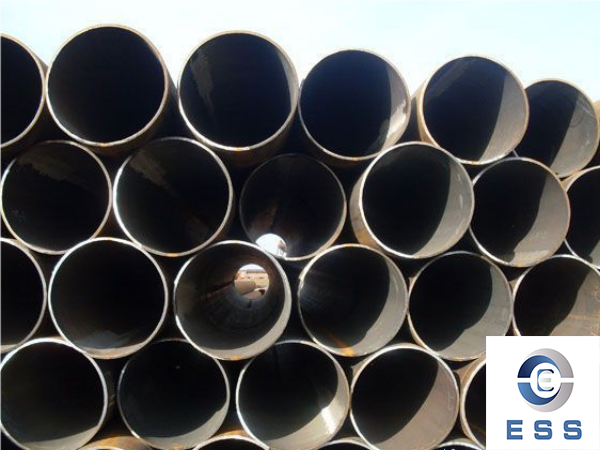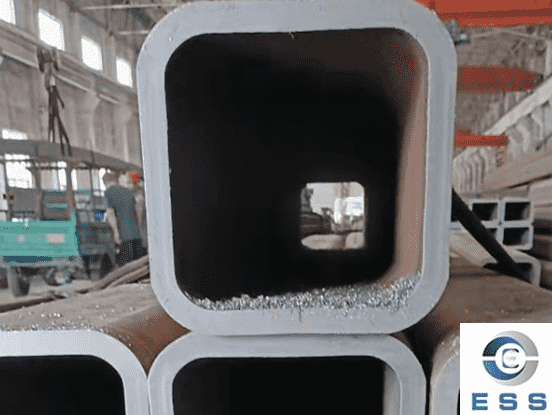The acceptance steps of LSAW steel pipe and ERW pipe
What is LSAW steel pipe?
LSAW steel pipe (Longitudinally Submerged Arc Welding, abbreviated as LSAW) is a professional term for straight seam submerged arc welded steel pipe. It uses a single medium-thick plate as raw material, and presses (rolls) the steel plate into a tube blank in a mold or forming machine, using double-sided Pipes produced by submerged arc welding and diameter expansion.

LSAW steel pipes have a wide range of finished product specifications, and the welds have good toughness, plasticity, uniformity and density. They have the advantages of large pipe diameter, thick pipe wall, high pressure resistance, low temperature resistance and strong corrosion resistance. When constructing high-strength, high-quality long-distance oil and gas pipelines, most of the steel pipes required are large-diameter, thick-walled straight seam submerged arc welded pipes. According to API standards, in large-scale oil and gas transmission pipelines, when passing through Class 1 and Class 2 areas such as alpine zones, seabed, and densely populated urban areas, longitudinal submerged arc welded pipes are the only designated applicable pipe type.
According to different molding methods, it can be divided into:
UOE steel pipe: After the single steel plate is pre-bent at the edge, it undergoes processes such as U forming, O forming, internal welding, external welding, and mechanical cold expansion.
JCOE steel pipe: that is, pre-welding, forming, and cold expansion after welding according to "J-C-O-E"
HME steel pipe: formed by mandrel rolling method according to "C-C-O", welded and then cold expanded.
What is an ERW pipe?
ERW is a general term for resistance welded steel pipes. Straight seam high-frequency resistance welding pipe (Electric Resistance Welding, referred to as ERW). ERW is the first letter of the corresponding English word. Resistance welded steel pipes are divided into two forms: AC welded steel pipes and DC welded steel pipes.

AC welding is divided into low frequency welding, medium frequency welding, super medium frequency welding and high frequency welding according to the frequency. High-frequency welding is mainly used for the production of thin-walled steel pipes or ordinary-walled steel pipes. High-frequency welding is divided into contact welding and induction welding. DC welding is generally used for small diameter steel pipes.
Therefore, in summary, high-frequency welded pipe is included in ERW welded pipe, which is a kind of ERW welded pipe produced by high-frequency welding process. ERW straight seam welded pipe is a steel pipe with advanced product performance, leading quality and relatively economical performance in the field of oil and gas storage and transportation.
ERW straight seam welded pipe is generally used as wire casing in the electric power industry. Performance features: 100% ultrasonic testing of the base material ensures the inherent quality of the pipe body; there is no unwinding-disc shearing process, base metal pitting , less scratches; there is basically no residual stress in the finished pipe after stress relief; the welding seam is short, and the probability of defects is small; moist sour natural gas can be transported conditionally; after diameter expansion, the geometric size accuracy of the steel pipe is high; welding It is carried out in a straight line in a horizontal position after the molding is completed. Therefore, the staggered edges, seams, and pipe diameter and circumference are well controlled, and the welding quality is excellent.
Acceptance steps for LSAW steel pipe and ERW pipe
1. The approval procedures for batch acceptance of straight seam steel pipes should comply with the provisions of the corresponding product standards.
2. The inspection items, sampling quantity, sampling location and test methods of straight seam steel pipes should comply with the corresponding product standards. With the buyer's consent, hot-rolled seamless straight seam steel pipes can be sampled in batches according to the rolling root array.
3. In the inspection results of straight seam steel pipes, if any item does not meet the product standard requirements, the unqualified items should be selected, and double the number of samples should be taken from the same batch of straight seam steel pipes to re-inspect the unqualified items. If the re-inspection results (including various indicators required for engineering tests) do not meet the standards, the batch of straight seam steel pipes shall not leave the factory.
4. Straight seam steel pipes that do not meet the standards (including items whose initial inspection results do not meet the standard and are not allowed to be re-inspected) should be submitted to the supplier for acceptance one by one; or a new batch of reheat treatments should be proposed (the number of reheat treatments should not exceed twice) acceptance.
5. If there are no special provisions in product standards, the chemical composition of straight seam steel pipes shall be accepted according to the melting composition.
What is the difference between straight seam steel pipe and high frequency straight seam steel pipe? Straight seam steel pipe refers to a welded steel pipe with only one longitudinal weld. According to GB/9711.1, when the diameter of a straight seam steel pipe is greater than 914.4 and the weld angle is 180°, there can be two straight seams. The weld quality requirements are the same as those of straight seam steel pipes.
According to the production process, it can be divided into ERW high-frequency straight seam steel pipe, JCOE straight seam steel pipe and rolled straight seam steel pipe.
Straight seam steel pipe is a general term for high-frequency straight seam, submerged arc straight seam, electric welding straight seam, pipe straight seam, etc. High-frequency straight seam steel pipe uses high-frequency current skin effect to generate high temperature and external short-term force squeeze at both ends of the steel plate. Pressure, it is a true electrodeless base metal butt joint. Using hot-rolled coils as raw materials, the wall thickness of ERW high-frequency straight seam steel pipes can be controlled to about ±0.2mm. The ends of the steel pipes comply with the American APL standard or GB/T 9711.1 standard. The ends of the pipes are cut, and the length of transportation is fixed. of. In recent years, ERW steel pipes have been widely used as the main steel pipes in natural gas pipeline network projects and gas company urban pipe networks. Currently, ERW high-frequency straight seam steel pipes account for 60% of the world's steel pipes.
Straight seam steel pipe refers to double-sided submerged arc straight seam steel pipe. The JCOE cold forming process is used, the welding seam is made of welding wire, and granular flux is used for submerged arc, which is called submerged arc straight seam steel pipe. The main production process of submerged arc welded straight seam steel pipes is flexible and can produce any specifications and wall thickness between 325 mm and 1420 mm. It largely meets international steel pipe size requirements, while high-frequency straight seam steel pipes are usually used in the production of domestic specifications.
High frequency straight seam steel pipe is often called the original pipe. This industry is different from the names of submerged arc welded straight seam steel pipes or thermally expanded high frequency straight seam steel pipes.













 Eastern Steel Manufacturing Co.,Ltd not only improve product production and sales services, but also provide additional value-added services. As long as you need, we can complete your specific needs together.
Eastern Steel Manufacturing Co.,Ltd not only improve product production and sales services, but also provide additional value-added services. As long as you need, we can complete your specific needs together.











